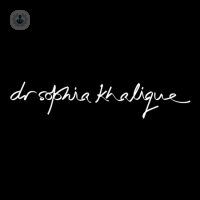Hormone replacement therapy (HRT)
Mr Chellappah Gnanachandran - Obstetrics & gynaecology
Created on: 06-06-2017
Updated on: 02-12-2024
Edited by: Conor Dunworth
What is menopausal hormone therapy?
Menopausal hormone therapy, and more specifically hormone replacement therapy, involves taking medication to replace oestrogen lost during the menopause.
Menopausal hormone therapy is one of many types of hormone replacement therapy. Hormone replacement can also be offered to:
- men experiencing a loss in testosterone as part of the “male menopause”
- transgender people looking to align their secondary sexual characteristics with their identified gender

Why is menopausal hormone therapy done?
As women approach the menopause their levels of oestrogen fall, leading to a number of uncomfortable symptoms such as:
- hot flushes
- mood swings
- loss of libido
- vaginal dryness
Hormone replacement can help to maintain the levels of oestrogen in the body, and combat some of these symptoms.
It's particularly recommended in women who experience an early menopause, as they are at a higher risk of heart disease, anxiety, depression, or parkinsonism if their oestrogen levels are too low.
Finally, hormone replacement therapy has also been found to help prevent bone loss and reduce the risk of fragility fractures.
Hormone replacement therapy is not likely to be recommended if you have a history of womb, ovarian or breast cancer, or if you have a history of blood clots.
What does menopausal hormone therapy involve?
Hormone replacement therapy involves taking medication on a regular basis.
There are different ways to take the medication, including as a pill, cream, or skin patch. You can also take the medication continuously or in cycles.
Unless you have had a hysterectomy, it’s likely you will need to take progesterone in addition to oestrogen, to reduce your risk of developing uterine cancer.
It’s important to discuss the risks and benefits of hormone replacement therapy thoroughly with your doctor before making a decision. While there are many benefits (as described above), hormone replacement therapy can increase your risk of breast cancer and stroke. Side effects can include:
- bloating and indigestion
- headaches
- tenderness or swelling in your breasts
- nausea
- vaginal bleeding

What are the alternatives?
If you ultimately feel that the risks and side effects for you outweigh the benefits, there are alternative ways of tackling menopause symptoms you can consider:
- alternative medication – to tackle symptoms such as hot flushes or night sweats, your doctor may recommend trying tibolone,clonidine, or in some cases, antidepressants. These have their own risks and side effects and these should be discussed thoroughly
- vaginal lubricant or moisturiser may tackle symptoms of vaginal dryness
- regular exercise can reduce hot flushes and boost your mood
- dietary changes – a healthy diet can keep your bones strong and help you maintain a healthy weight. Cutting down on caffeine or alcohol in particular can reduce hot flushes
- Sleep hygiene – you can help improve your sleep by relaxing before going to bed, and making sure the room is cool to avoid night sweats
What are the risks of HRT?
Hormone replacement therapy can come with some risks, however in most cases these are outweighed by the benefits. The risks include:
- Heart disease
- Blood clots
- Breast cancer
- Stroke
The risks of HRT vary a lot depending on factors such as:
- Age: if you begin HRT before the age of 60, then you are at a much less likely to suffer from the above risks.
- Dosage: the risk of developing problems due to HRT depends on the given dose.
- Progestin: the risks of hormone replacement therapy are much greater if just oestrogen is given, as opposed to oestrogen given in combination with progestin.
- General health history: another important indicator of whether or not hormone replacement therapy is right for you is the health history of you and your family. If there is a history of heart disease, cancer, stroke, blood clots, osteoporosis or liver disease, HRT may not be suitable for you.
- High blood pressure: If you have a history of high blood pressure, you will need to lower it and get it under control before you can start HRT.
- Pregnancy: HRT is generally not suitable for pregnant women or women who breastfeed.
Before beginning your hormone replacement therapy, your doctor will discuss all of these risk factors with you in detail.
How does HRT work for transgender women?
HRT for transgender women, also known as feminising hormone therapy, is when hormone medicine (containing oestrogen as a main component) is used to help transgender women feel like their body aligns better with their gender identity. It also helps block the production of the male hormone testosterone.
Over time, the oestrogen component of the hormone therapy will start to cause the patient to see a number of changes in their body, such as:
- Softer skin
- Breasts
- Change in the shape of the body, including more fat on the hips, face and buttocks.
It can also lead to mood changes and anxiety.

Another part of feminising hormone therapy is blocking the body from producing testosterone. This will lead to changes such as:
- Fewer erections and ejaculation
- A decrease in libido
- Smaller testicles
- Less body hair and facial hair
- Decrease in muscle mass
The changes mentioned above usually start to take effect after about one month, but it may take up to three years to see the effects.
Why do transgender women undergo HRT?
Transgender women undergo HRT to help better align their physical body to their gender identity. Studies have shown that it can greatly improve the psychological wellbeing of of transgender people, as it can lessen the symptoms of psychological distress associated with gender dysphoria.















